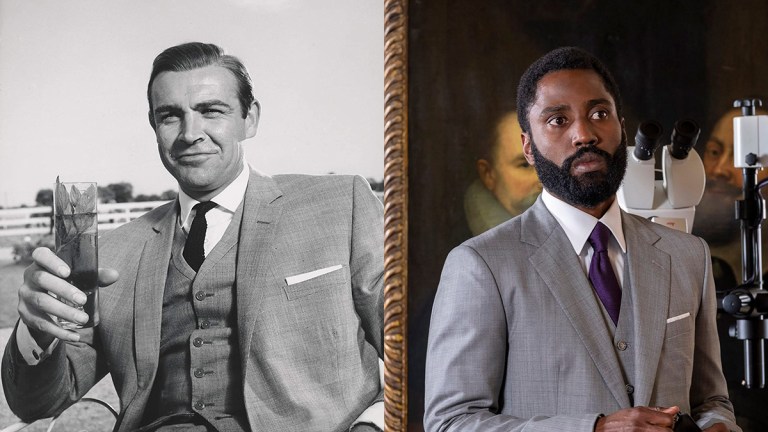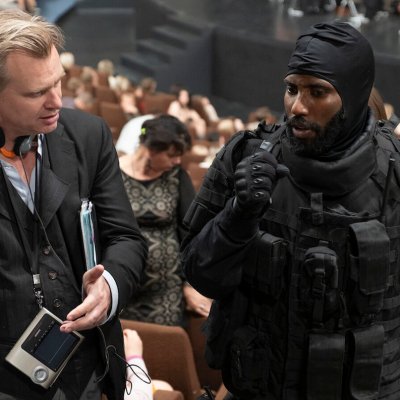Tenet Is Christopher Nolan’s Unofficial James Bond Movie
Christopher Nolan has said more than once he’s open to making a Bond movie. He finally did it with Tenet.

This article contains Tenet spoilers.
Throughout the Daniel Craig era of James Bond, the influence of Christopher Nolan has been hard to miss. A year after Nolan reinvented Dark Knight mythology with Batman Begins, and created the industry term of a “reboot” in the process, 007 had his own back-to-basics reset in Casino Royale. And following The Dark Knight’s praise for reconfiguring its iconography again for a post-War on Terror world, Skyfall would receive similar acclaim a few years later for its chilly, realpolitik tone.
But no matter how many developments in the Bond canon end up attributed to Nolan’s influence, it should be recognized that Bond influenced him first. That fact is almost inescapable after watching Tenet, which just premiered on HBO Max. It’s the filmmaker’s latest time-bending thriller, and the one that most resembles a 007 flick. With its smoothly dressed secret agent hero, its allusions to British intelligence, and its plot about a megalomaniacal Russian seeking to destroy the world, it’s a wonder John David Washington never once drained a dry martini.
More than any of the films before it, Tenet crystallizes that Nolan has always been chasing James Bond. And with this new film, the Memento director finally went ahead and remade that character in his coolly nonlinear image.
For more than a decade, the 50-year-old filmmaker has not been shy about his admiration for the Bond movies that captured his imagination as a child. At the 2010 London premiere of Inception, he even celebrated the similarities between his work and the Bond oeuvre.
“The Bond influence on the film was very intentional because, for me growing up with the Bond films, they’ve always stood for grand scale action,” Nolan said (via BBC). Those early 007 films from his youth, starring Sean Connery, George Lazenby, and Roger Moore, all “stood for the promise of being taken some place bigger than you could have imagined.” In an Empire print interview from the same year, he confessed, “I’ve been plundering ruthlessly from the Bond movies in everything I’ve done, forever. They’re a huge influence on me.”
And you can see it in every action film he’s made since 2005, beginning with the groundbreaking Batman Begins. While his origin story for the Dark Knight might have influenced how grounded Bond producers took their own 007 reboot less than 18 months later, the Bond influence on Nolan’s vision of Batman was there from the outset. It’s even in one of the key appeals of all three of Nolan’s Batman movies: his desire to open Bruce Wayne’s world up and depict him as a jetsetting crusader living in a larger global community, as opposed to in a contained Never Never Land version of Gotham City. The desire to show exotic locales like Iceland (doubling as the Himalayas) and Hong Kong visibly came from Eon Productions’ depiction of Bond as an adventurer always on the move.
More specifically, Nolan’s reinvention of the Lucius Fox character (played by Morgan Freeman) was modeled wholly after Desmond Llewelyn’s Q, the gadget-making quartermaster and occasional sidekick of 007 across nearly 40 years of Bond movies. Similarly, the focus on the chic habits and hobbies of the ultra-rich in those films (and many others of Nolan’s films, actually) likewise stems from 007.
As the Batman sequels continued to heighten the tension throughout The Dark Knight Trilogy, the influences of Bond also became only more pronounced. With each new film, the villain of the piece got a table-setting prologue action sequence that acted in a similar fashion to Bond movies’ famed pre-title sequences, and Bane’s aerial hijacking of a CIA plane over Scotland in The Dark Knight Rises is particularly a much more sophisticated riff on the same concept that starts License to Kill (1989).
Similarly, Batman kidnaps a Chinese national out of Hong Kong in The Dark Knight by holding onto him as an airplane grabs a cable tethered between the superhero’s back and a balloon floating in the sky—thereby yanking both into the air. Lucius Fox says he got the idea from “a program the CIA had back in the ‘60s called Skyhook.” And it’s true, that program existed, but Nolan almost certainly got the idea from the 1965 Bond movie, Thunderball, where Sean Connery and Claudine Auger (or at least their stunt dummies) are yanked out of the Caribbean and into the wide blue yonder.
Even the third act twist of The Dark Knight Rises, where it’s revealed that Tom Hardy’s dastardly Bane is actually subservient to (and in love with?) the woman Bruce thought he cared for is taken more or less from the underrated Pierce Brosnan Bond film, The World Is Not Enough (1999).
Eleven years ago, Inception was simply more brazen about these lifts, with its finely tailored heroes never needing to don superhero threads, and with a third act in large part focused on a ski and snowmobile raid of a fortress taken right out of On Her Majesty’s Secret Service (1969), which Nolan just happened to call his favorite Bond film. At the time of Inception’s release, he also called the dream-based actioner “absolutely my Bond movie.”
Nevertheless, with Inception’s structure being more derived from heist thrillers than spy movies, and its hero being a family man haunted by past mistakes instead of an international man of mystery, the filmmaker’s thoughts on that being “my Bond movie” have softened over the years. In 2017, he told Playboy (via Business Insider) that he’d “definitely” consider doing a Bond movie one day.
One might assume Tenet is that movie, or as close to it as possible.
In both Nolan’s Batman movies and Inception, the filmmaker grafted Bond inspirations onto the existing structures of superhero lore and heist movie conventions. Yet with Tenet, Nolan finally embraces the spy movie’s form… while still situating those conventions within his own distinct obsessions and narrative sleights of hand.
Excluding the most recent Bond movies starring Craig, the 007 of the screen has always been defined by his impenetrable ambiguity. Connery’s Bond never talked about his childhood or parents, Moore’s Bond never had any lingering attachments to friends or lovers beyond the current adventure he was already in, and the only acquaintances in their lives were work colleagues like Q, M, Miss Moneypenny, and poor hapless Felix Leiter from the CIA. With two notable exceptions, we never even saw the inside of Bond’s flat for the first 50 years of cinematic exploits.
Tenet thus takes that idea of a mysterious presence as the lead character to its extreme. Washington’s protagonist is even rather cloyingly named just that: the Protagonist. He has no family, friends, backstory, or even 007’s defining vices of vodka and sex. All we know is the Protagonist came up through the CIA before being recruited into the Tenet organization, and he doesn’t like it when colleagues are killed—well, that and he’s more inclined to drink a Diet Coke than a martini.
Still, he nestles into 007’s world neatly throughout the film. When he’s scolded by a marvelous Michael Caine for wearing a Brooks Brothers suit to a meeting at a London club so snooty that you’re chided for not addressing your betters by their titles, the Protagonist quips, “You British don’t have a monopoly on snobbery, you know.”
“Well not a monopoly,” Sir Michael smirks. “More of a controlling interest.”
In essence, Washington’s Protagonist is an interloper infiltrating the rich and privileged world most 007 actors are depicted as walking through as if it were their birthright. While there was a roughness around the edges to Connery’s original (and best) Bond, the character’s smirk implies he was born with the silver spoon, only no one realized it until he took it out of some other less deserving aristocrat’s mouth.
We likewise see Washington slowly assume that identity throughout Tenet, intentionally irritating the stuffiness of Sir Michael’s club, or joking about hot sauce in a high-end restaurant frequented by billionaires. Nonetheless, he assumes all the Bond airs smoothly and with minimal effort as the film progresses. After Michael’s condescension about his suit, the next time we see the Protagonist he’s wearing a tailored three-piece gray number which doesn’t look that far removed from Connery in Goldfinger.
And when he sits down to match wits with the film’s villain, a man named Sator (Kenneth Branagh), he Protagonist acts like Connery: a fella who claimed the privilege that was mistakenly denied at his birth. When the Protagonist is asked if he’s slept with the villain’s wife, the way he so subtly smirks while saying, “No. Not yet,” would do Connery proud.
But then Sator, perhaps even more so than the Protagonist, is what makes Tenet a near full-on Bond movie. Following in the grand tradition of British actors adopting bad Russian accents to play heavies, Branagh’s Sator lives the life of a super-evil megalomaniac on his yachts and high on his vices.
Those trapping may be more sophisticated than the Bond movies’ often comic book-level depictions of wealth and power—hollowed out volcanoes and swimming pools filled with sharks—but for all of Sator’s musings about the paintings of Goya and Freeport tax havens, or the F50 foiling catamaran sailboats he flaunts in front of the Protagonist, he’s still a Bond villain who wants to conquer/destroy the world. In his case, it’s because of the complicated science fiction methods of a future generation wanting to wipe us out. Still, Sator’s function is all so much fodder for a third act monologue.
Where this becomes most apparent is his relationship with his wife Katharine (Elizabeth Debicki). A woman trapped in a toxic abusive marriage by literal blackmail, Debicki’s Kat is intended to be more developed than a typical Bond girl (not to mention many of the leading roles for women in Nolan movies). We see her twisted relationship with Sator strictly from her point-of-view as a mother living under duress, with her husband threatening to send her to prison if she ever attempts to leave with their son. In fact, he twists the knife further by saying he’d only allow her to leave if he kept the child he doesn’t even care about.
However, the Protagonist trying to get to the supervillain through the manipulation of his lover is Bond movie plotting 101. The Dark Knight might’ve borrowed the Skyhook concept from Thunderball, but Tenet lifts the central romantic triangle conflict in total, with the hero pressuring a woman to spy on and undermine a villain who’s essentially middle management for the bigger threat (SPECTRE in Thunderball, vengeful future generations in Tenet).
There’s more complexity to Kat than Thunderball’s Domino, and she nor the Protagonist need an intimate rendezvous under the sea for her to turn. She’s already ready to do that long before the Protagonist shows up. However, she is still, at least in one scene, the damsel in distress who must be saved, and the woman who’s also tortured and beaten by the man who keeps her under constant surveillance.
At least, also like Domino, Kat gets to kill the villain by shooting him on a yacht. Kat’s victory over Sator is more satisfying, too, since she does it to quench her own thirst for revenge and not to save the hero.
“I’m not the woman who could find love for you even though you scarred her on the inside,” she says, drawing the gun. “I’m the vengeful bitch you scarred on the outside.”
For all of Tenet’s confusing misdirections and head-spinning discussions about inverted entropies, paradoxes, and parallel worlds, it is in essence a spy thriller right out of the 007 template. But does that make it better or worse? The answer might be somewhere in the middle.
Like all of Nolan’s spectacle films, there is something to be said about Tenet’s fidelity to in-camera stunts and action. Nolan’s seen enough Bond movies over the decades to know the images that stay with you and hold up many years later are the ones where actors (or stuntpeople) are doing it for real. So original death-defying imagery, such as when the Protagonist and Neil (Robert Pattinson) bungee jump upwards and above a Mumbai high-rise, or a third act climax in which filmmakers simultaneously shoot vehicles moving forward and backward, is thrilling stuff. (The movie finishing in a third act siege is also taken from Thunderball and numerous other Bond movies, by the by.)
But personally, one of the greater appeals about Bond movies is their unapologetic desire to have fun. With few exceptions, the atmosphere is relatively lighthearted in each 007 adventure, or at least playful. Tenet, like all of Nolan’s films, has a somber earnestness about it, which makes the slipperiness of its protagonist harder to hang onto, and the motivations of its villain less credible in a story about our descendants trying to wipe us out over climate change.
In many ways, Tenet is denser and less mischievous than any of Nolan’s brooding Batman efforts or Inception, which is a picture where the central protagonist is a grieving widower. It’s one of the reasons, I suspect, Tenet has left a lot of viewers cold. So if this really is the closest Nolan ever gets to doing a 007 movie, maybe it’s for the best.


